Layoffs & Discharges drop further, and are far lower than before the pandemic, as employers cling to their workers.
By Wolf Richter for WOLF STREET.
Layoffs and discharges fell for the second month in a row, to 1.51 million in April, seasonally adjusted, the lowest since December 2022 during the labor shortages, and down substantially from the pre-pandemic range (blue in the chart).
The three-month moving average, which irons out the month-to-month squiggles, fell to 1.60 million, also substantially below the prepandemic range (red).
This is a sign that, despite all the layoff headlines, employers are hanging on to their workers. Some economists have mused that employers are “hoarding” workers, rather than letting them go proactively, and that they’re doing so because they got burned with the labor shortages after their mass-layoffs during the pandemic. If true, that would be a good thing.
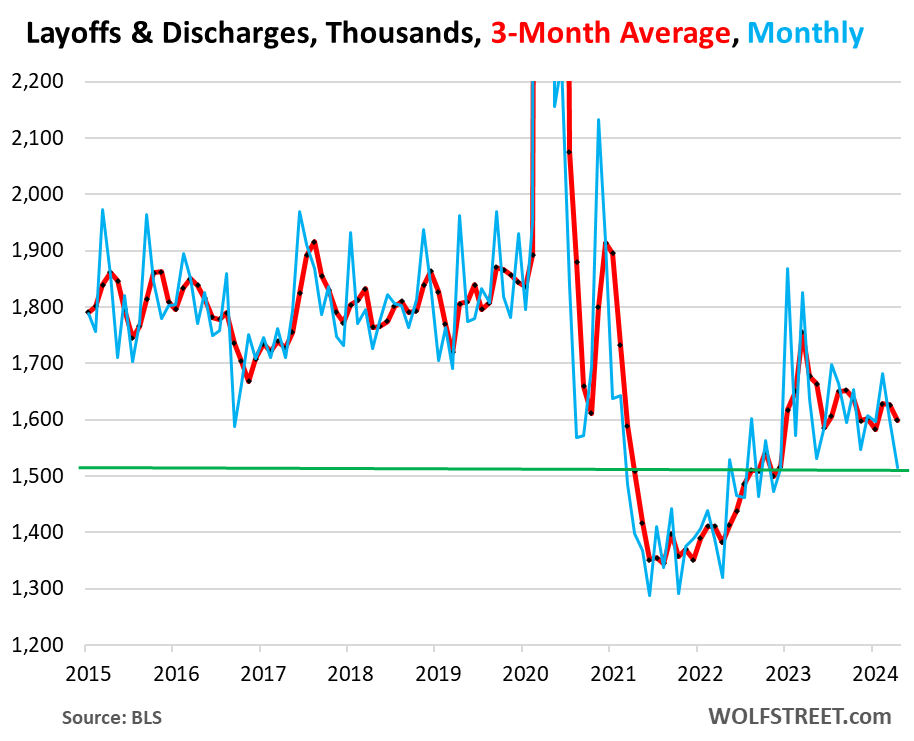
During the Good Times in 2014-2019, layoffs and discharges averaged 1.8 million per month. That was part of the normal way of business. During the Great Recession, monthly layoffs and discharges blew past 2.5 million. In March and April 2020, they averaged over 10 million.
This data is based on surveys of about 21,000 work sites, released today by the Bureau of Labor Statistics as part of its Job Openings and Labor Turnover Survey (JOLTS).
Layoffs and discharges compared to employment. Employment has grown over the years, and when compared to the magnitude of employment, the trend in layoffs and discharges becomes even clearer.
Layoffs and discharges fell to 0.96% of total nonfarm employment in April, the lowest since November 2022.
The three-month average fell to 1.01%, far below the prepandemic range. Employers are clinging to their workers, and they’re clinging to them more tightly than they did a year ago, and much more tightly than they did before the pandemic:
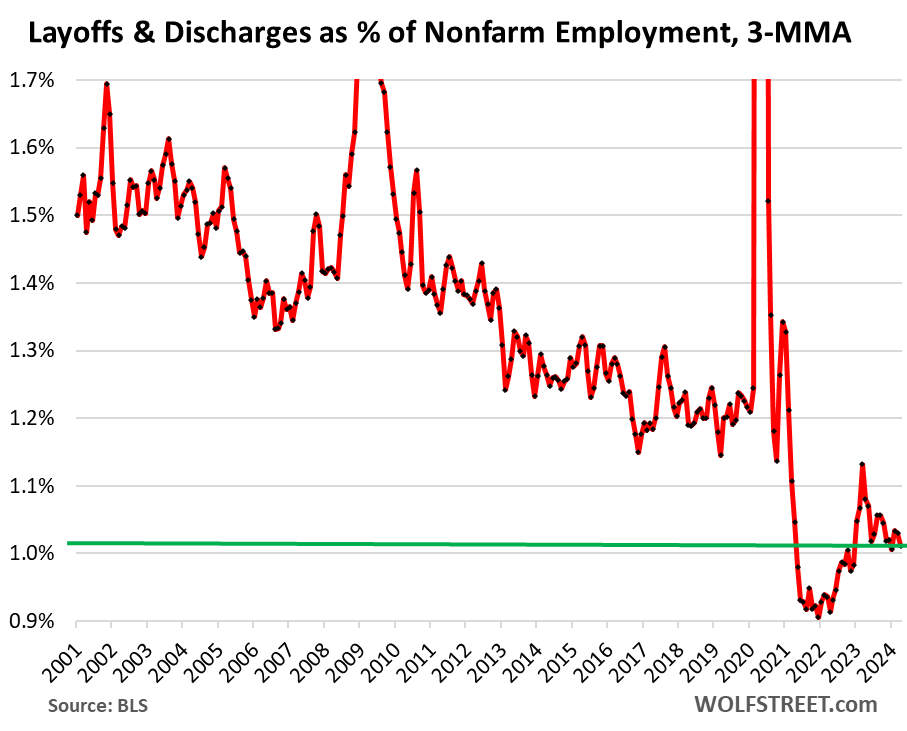
And workers stick to their jobs again. Voluntary quits ticked up to 3.51 million in April, but have remained in essentially the same range since August 2023 (blue). The three-month moving average ticked up to 3.48 million (red).
Quits have now stabilized at this level where they’d been before the pandemic. So the great resignation is over; workers no longer quit their jobs in these massive numbers. And employers are hanging on to them, and so the crazy and costly churn in 2021 and 2022 has calmed down, and employers need to hire fewer new people to replace the departing people.
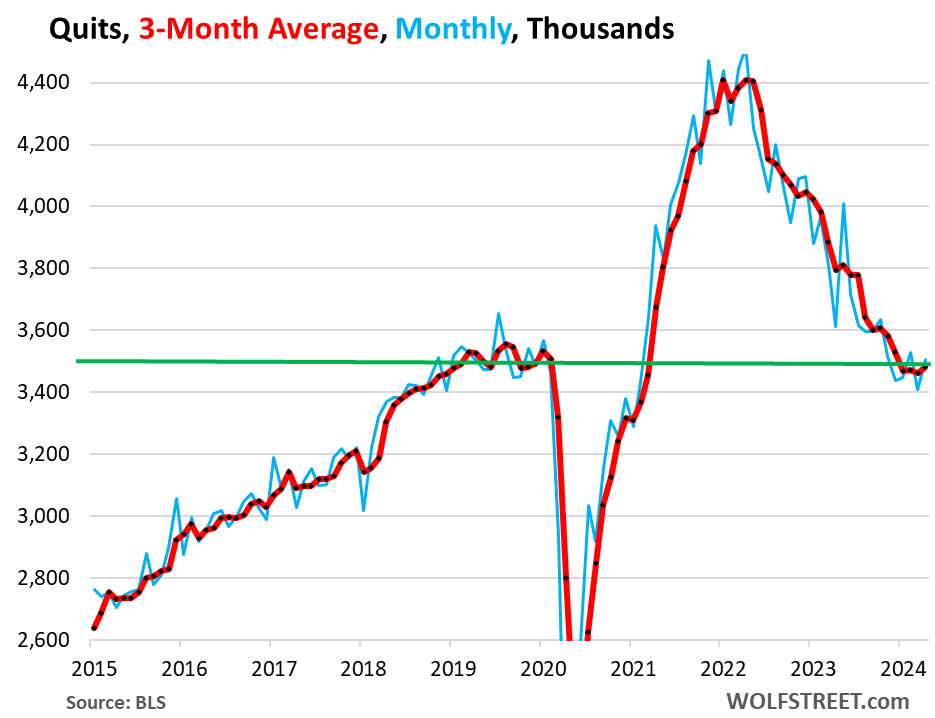
Job openings fell, as fewer openings were left behind by lower discharges and quits. In April, job openings fell to 8.06 million, the lowest since February 2021. The three-month average fell to 8.41 million, the lowest since March 2021. But both were still well above prepandemic levels:
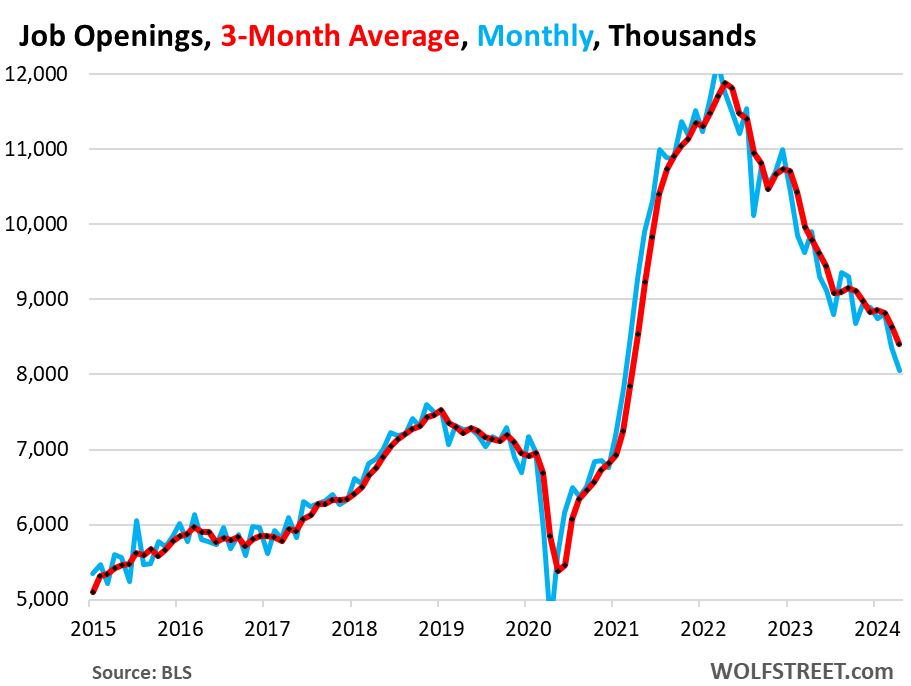
The ratio of job openings to nonfarm employment takes into account the growth of employment over the years. On this basis, job openings fell to 5.3% of nonfarm employment, the lowest since March 2021. The long-term chart shows just how historically high this rate of job openings still is – and it’s still far from normalized:
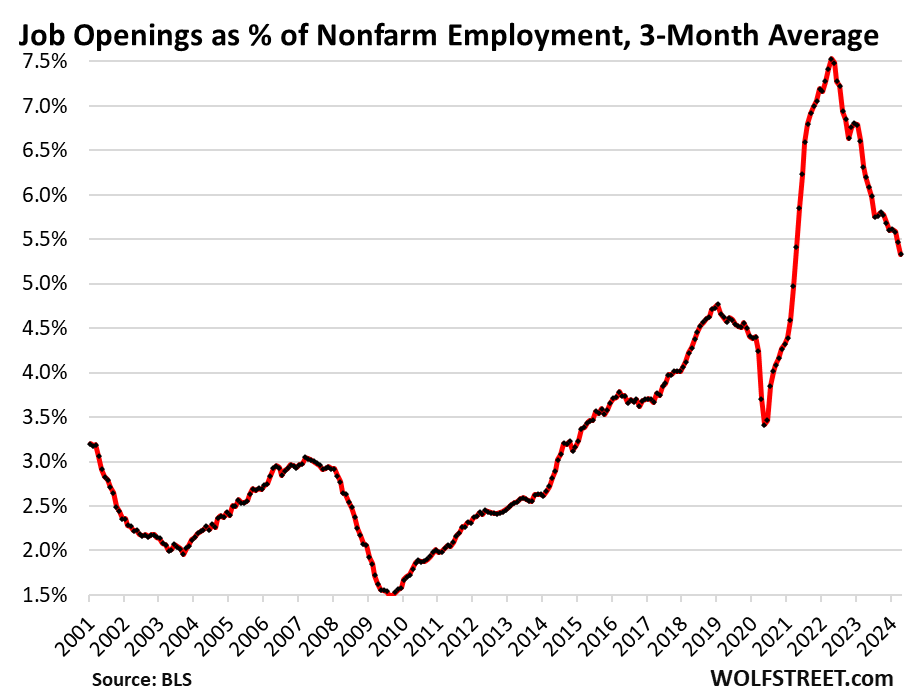
Hires ticked up to 5.64 million in April, and has remained roughly in the same range since November, and in the range of 2018 and 2019.
The three-month average dipped to 5.68 million, also roughly in the same range for six months.
As fewer people quit their jobs, and as fewer people were discharged, the need to fill newly vacant jobs declines, and so fewer people need to be hired to replace departing workers, and the churn in the workforce declines.
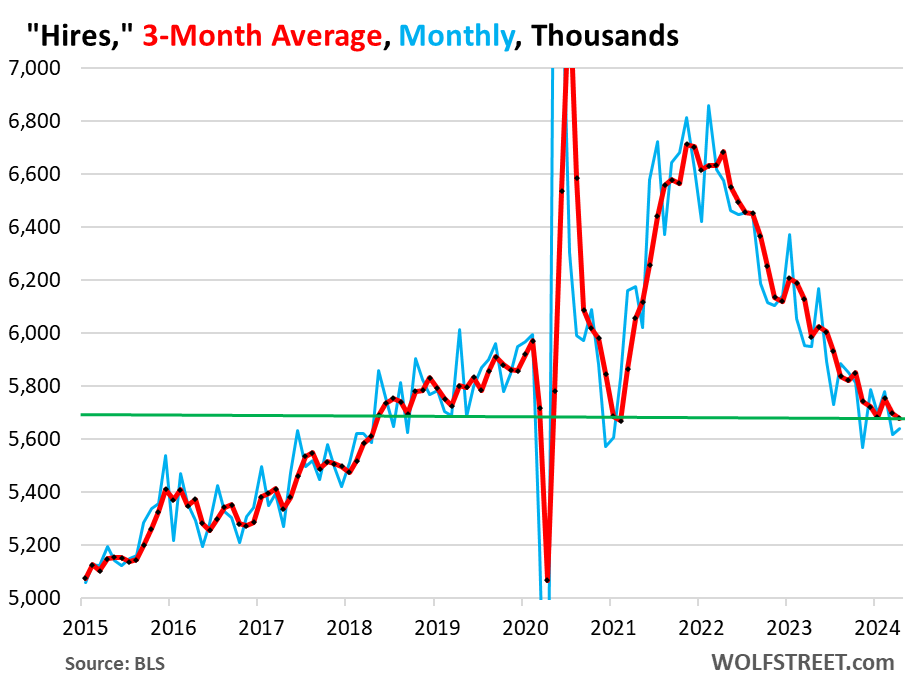
Powell often cites the data from the JOLTS report, among other labor market data, for signs of labor market tightness, for signs that the labor market moves back into balance. We can see that the wild and wooly labor shortages and churn during the pandemic are gone, that the labor market is no longer crazy-tight, as it was in 2021 and 2022. But it remains fairly tight, confirming a slew of other data, including the low levels of claims for unemployment insurance. And today’s data too is supporting the Fed’s wait-and-see on rate cuts.
Enjoy reading WOLF STREET and want to support it? You can donate. I appreciate it immensely. Click on the mug to find out how:
![]()


“Layoffs and discharges fell to 0.96% of total nonfarm employment in April, the lowest since November 2022.”
And then?
Markets rocketed higher!
Must be time to cut rates, print money or something? No way the economy can just grind along!
The recession will begin when the gold price bottoms (maybe lose 10-15%). Then everything else will fall, based on some great, unknown “margin call.”
Labor will suffer as a result of the next recession but will not cause it.
“Markets rocketed higher!”
Huh? The S&P 500 is up 0.1% today.
Jackson Y: In November 2022, the last time layoffs and discharges fell to this percentage of NFPs; markets rocketed higher.
Two words: N. Vidia.
As the FOMC statements say, “the labor market is coming into better balance.”
I agree. And there’s absolutely ZERO data pointing to a recession anytime soon. The labor market is quite strong, and like the Fed says more into a balanced regime. Assuming oil stays in a slump over the summer, we may see core inflation move from 3.6% now down towards 3%, setting the stage for the Fed’s first rate cut in September. If the labor market remains stable through next spring and the Fed makes two rate cuts, the 30YFRM will dip below 6% and home prices will start to solidly move higher.
I also see this AM a market roundup saying “markets grind higher on rate cut hopes” after a soft-ish payroll report.
I don’t think that markets WILL rocket higher this time…
I also didn’t see markets rising 50% since Oct. ‘22 bottom either, so I make inane comments here.
This is consistent with what I see around myself. Extremely few people are getting laid off. And for those who got laid off, after a few months from being laid off, they find another similar job. There is nobody I can see having a fear of unemployment. Everybody I see is very confident and relaxed about being employed. I think it will go like this at least several years.
I think you need to take a look at LinkedIn and read the many horror stories people have about being laid off and not being able to find new jobs even though they’ve sent out hundreds of resumes and had numerous interviews. This is primarily in information technology, but it may shift into other industries as well.
Structural labor shortages are the new normal. That second to last graph is extremely eye-opening.
JOLTS has been criticized for its reliability, partly due to survey size, but also due to effectively showing quantity over quality. With companies increasing sophistication of using the internet for recruitment, they have increased more of a catch all strategy, resulting in a big increase in the number of job postings. There is a big increase in speculative, “fake” and duplicate job postings (ie different sounding roles for what is really the same role), for example, which are not there to fulfil an immediate need. Basically, not all job postings are the same and the way Companies utilize technology has evolved over time.
Its likely the increase you see from 2010 to 2019 is the change in this trends, which likely continued into the 2020s albeit with the trend obfuscated by Covid. JOLTS is still a useful metric, but it does come with that health warning when looking at longer term trends.
I should say 2015 to 2019, not 2010, clearly some recovery from the 08/09 recession in there!
This is BS because JOLTS does NOT USE internet job postings. Doesn’t even look at them. Irrelevant for JOLTS. RTGDFA. I told you in the article how JOLTS gets the data.
“The tree-month moving average, which irons out …”
A tree-month moving average? Perhaps AI has already infiltrated your site. LOL
TreeMMA – it’s an industry term.
Maybe Wolf is from the south side of Chicago.
Tree terty tree.
The companies were hoarding all the office space in anticipation for future expansion, expansion that was never realized.
Now these companies are hoarding the workers in anticipation of future expansion.
Our country is hoarding working men and women from around the world in anticipation of future expansion.
Hope everybody gets work, if not, we’re going to have a lot of un-hoarding to do. I still have toilet paper left over from my hoarding days of yore.
I’ll add that many of those companies hoarding all the office space in anticipation of future expansion made out well, but without all that RE overhead. And yes, many of those companies are thriving in this environment, with remote staff.
LOL, in a week 10 year bond rates went from racing back to cycle highs to dropping like a rock. I swear, If these people come out dovish bc one month of manufacturing and employment I’m going to do absolutely nothing. The haves and have not separation is only becoming greater bc of these people.
Max,
I would propose the have and have not problem is systemic in our system and has been going on for many decades. Perhaps more noticable now as it is impacting more people.
Hey, this is the country of individual exceptionalism. If you aren’t a multiple millionaire then it is on you for not working hard enough!
I hardly put the state of inequality on Wall Street and the Fed.
I am someone about who other people may say I did exceedingly well based on individual exceptionalism.
Let me tell you, I did well not because of hard work and/or intelligence. I did well because of Govt Policies.
Wealth inequality is increasing day by day because of Govt policies.
I have friends who made 10s of millions because they bought bitcoin few years back for 10s of dollars.
Nothing like regulatory capture and de facto monopolies.
“Go forth and make money, but always kick up” is the commandment.
I always find myself in the between space of things.
Hate the sin, not the sinner? I like to believe so, but I just know how to play the game. Good luck.
Seems like serious gaps in some areas that will continue to grow, such as the healthcare field. Will be interesting to see if wages go up or simply the quality of care declines. Seems like just more potential for added services inflation. You can’t AI care in most cases.
How is AI care any different from telecare? A decade from now, AI diagnosis will probably exceed the capabiliity of telecare diagnosis by a wide margin. The AI will be able to ask better questions, and can draw from both a wider and deeper pool of both case studies and up to date knowledge. Doctors office visits will still give the doctor the advantage, but office visits are opposite the direction healthcare is moving.
JeffD: AI care is quite similar to telehealth.
I wouldn’t call it telecare?
I have never heard of a provider starting an IV Or treating a patient at ALL over the phone.
A diagnosis is just a chosen pathway for treatment and a token for insurance to hold onto and provide (or limit) services.
Healthcare is going the way of computing for sure: More and better resources than ever (imagined), lower quality of production and value creation.
How much computing power and energy goes into junk crypto and AI plagiarism?
How much healthcare is diverted from the patient by regulations and insurance?
(I have wondered about the profitability of insurance companies. The idea WAS “shared risk” but they are not sharing well)
The Lone Wolf Howells Again. Everywhere else, sky is falling, recession is already here because the FED has rates too high……Somebody needs to slap or smack a hammer on the side of AI ………
Some headlines saying a rate cut is imminent. Labor market falling off a cliff. 🤣😂🤣
Labor market is clearly cooling here in flyover country. Not cold, just cooling. We just picked up two solid employees laid off as part of broad layoffs from a nearby farm equipment manufacturer. Another interviewee from a nearby metal fabrication shop said they were on the border of killing a shift and all their locations were very slow, on the verge of layoffs. Last Friday our second largest metals supplier said their first quarter was really strong then just dropped off suddenly and they’re “relatively slow” right now. They have broad expslosure to a lot of different markets from construction to ag to transportation. Our truck equipment backlog has dropped by about half from its all time high and is still falling quickly. We are booked lightly but safely through summer, but who knows after that.
Last time our backlog hit this level, orders took off like a rocket and set new all time highs so I’m withholding judgement on where this goes next. If this slowdown continues, we will hang on to our employees until it hurts because it has been so difficult to staff appropriately for the last three years. I’m already warming up a big stock order to keep the guys busy in July replenishing our now-sparse stock program. But at some point, the math doesn’t make sense and head count has to adjust commensurate to revenue or we start burning cash like a Silicon Valley startup.
Same report in my sliver of flyover. Our business is tied to construction.
Try to tell the youngsters to save during the good times, to ride out the bad. We can’t afford to lose them like we did in GFC.
This matches up with a lot of what I am hearing from a few of the small manufacturing business I did some consulting for a few years ago. The ones I still keep in contact with all pretty much say the same things. Business is going really strong, all of them could use more workers, but they aren’t so desperate that they will just hire anyone with a pulse like they would before. Instead they are posting a few jobs, not getting a whole lot of applicants, but just enough quality candidates to fill required positions. Employee turnover has dropped a lot.
Basically they think the job market is tight, but enough quality is coming through to keep them going and not as much is leaving. Almost like an equilbrium has been reached.
* If this slowdown continues, we will hang on to our employees until it hurts because it has been so difficult to staff appropriately for the last three years.*
Which is exactly the “hoarding” hypothesis Wolf refers to in the article. Interesting.
If this attitude is indeed widespread, employment data has become a lagging indicator, hasn’t it?
Loss of employment trigger recessions, not the other way around. Loss of employment is a trigger, not a lagging indicator. If a large number of people get laid off, not only do they cut back drastically, but others still working get scared and cut back. So consumer spending drops, and that’s the beginning of a classic business-cycle recession.
In my little burg in East Central Florida, we have the opposite problem. We’ve had two fast food restaurants simply collapse from ownership’s unwillingness to hire, train and pay fast food workers. I was in a KFC, very rare for me, to find the shift supervisor in tears because a couple of workers just quit and walked out and she knew she wouldn’t be able to replace them. I decided to walk out myself out of concern for the quality of production with the level of understaffing and frustration.
The recent drop in oil prices should add some extra spending power to consumer for the summer boost. Could be some goods besides services that rises this summer with employment strong
Still five job openings for every four unemployed people, yet somehow the media and wallstreet paint this as evidence of a poor economy. Inflation is still firmly entrenched and that’s not likely to change any time soon. The economy continues to be overheated, in spite of media reports of the end of the world.
Anecdotally, oter than a few specialized fields, I simply do not see an abundance of jobs, even for recent graduates. GenZers are working two or three McJobs, with little opportunity to move on to better things,
As for the old, many geezers, even in high demand areas, will never be able to replace their well paid positions. For many, a lay off in the 50’s is an economic death sentence.
“GenZers are working two or three McJobs,”
Maybe you live in the wrong place? Recent immigrants do the McJobs here. The GenZers around me are in tech jobs and pull $100k+
In terms of “the old,” true, ageism is a huge thing: young managers (GenZers, millennials) loathe hiring older people, especially in tech.
Is San Francisco “the right place”? Lol the bay area is hardly a bellwether for employment conditions around the entire country and it’s outrageous costs are not exactly welcoming to young people either.
“… it’s outrageous costs are not exactly welcoming to young people either.”
Correct. But they’re here.
I feel for the over-50 crowd, and the very real ageism that happens in the workplace. It’s easy to blame the system or businesses, but the workers bear some responsibility here too. My skills will probably be mismatched to the job market in a decade or three, so I am trying to prepare by learning new things, and saving money so I can bail on my own terms when I am unwanted in the workforce. Using excel and uploading .CSV files is still practically a superpower in our business, so I am good for at least a little while.
We’ve had to “drag across the finish line” several employees in the last few years. Only upon their retirement do we learn just how stunningly ineffective and inefficient they were in their roles. Most of this is due to a lack of technology adoption. Two guys were just completely burnt out, in poor health, and dragging their aching bodies to work every day until they were eligible for Medicare and Social Security.
It used to take our accounting person at least two days to close a month. When she retired, we were forced to rethink the role. I was able to reduce the process to two hours by bringing excel into the process to simply make a pivot table, edit, and import the journal entries into the ERP system as a .CSV. Payroll used to also take her a day or two. Our new payroll person handles it remotely in a few hours per week after implementing an online platform. We offered training on Microsoft Office Suite, and it went nowhere if the employee was over 50.
Our new weld shop supervisor is running circles around his predecessor after a year on the job. He is younger and thus a digital native. The former guy has a heart of gold, and some useful tribal knowledge, but he typed with two pointer fingers. No matter how many times we explained it, he could never grasp how our fancy works scheduling software operated, and why his shortsighted actions were breaking it daily. He badly wanted to retire, and we wanted him to retire just the same.
As someone over 50 with a wife who also is over 50, I think the key to finding employment is flexibility and a willingness to learn.
Unfortunately there are a ton of people over 50 who are set in their ways and only want to do things like they learned 20 years ago.
My wife has job hopped a lot in the past 5 years. I think there are employers who will value the years of experience as long as it is coupled with a willingness to change, learn, and adapt. In fact, we are finding that to the right type of employer, finding a good candidate over 50 is like finding gold. You get the experience in addition to the skillset.
Of course many of that age are not willing to adapt.
I’m confused by a lot of this data, but it’s most likely because of the industry I’m in. I work in biotech in California, and there have been thousands of layoffs and full on company closures over the last few months. Nearly every person I know has either lost their job or is concerned about losing it.
Is biotech likely hit harder because the chase for covid drugs and test kits is effectively over? I’m not trying to make a biased statement. I’m legitimately confused why my area and industry is being hit hard by layoffs and cost cutting, and yet data isn’t even showing a blip.
The small biotech companies burn cash. They exist to be acquired by Big pharma. As an independent entities, they have uncertain prospects. Meanwhile, interest rates are up. And the stock market has probably topped and likely goes side way or down. So in your niche, this isn’t the best of times. It takes years to develop drugs. Sometimes market conditions don’t furnish that runway. And to get to launch you have to lay off personnel and preserve cash.
Biotech was in a total bubble for years, and it blew up royally. Lots of biotech startups have shut down. It’s in the no-products startups where the bloodletting is happening. They can’t get another round of funding, run out of money, and trim back or shut down. But it’s a tiny sector in the overall economy.
There were other sectors that totally blew up, such as mortgage bankers in 2023. Mass layoffs, one after the other, because their revenues collapsed because refis collapsed. We covered that at the time. But it’s just a tiny sector in the overall economy.
What we got is a “soft landing” with a barely perceptible correction in the prices of some assets.
From here to there, I can only hope for a “black swan” that will seriously correct asset prices.
Julian: Still no “landing.”
I see a stagflationary environment for the near term. Positive GDP. Positive inflation.
Asset prices are not the economy (which has confused many for the past decades).
I’m not sure if there’s been a shovel in the ground yet for the “Four Seasons” project in Telluride (‘30 years in the making’)? I suspect when the foundation is just over half done the economy will roll over. It’s just a classic scenario, many buildings were half done for a decade post GFC.
We have so many opening in healthcare that go unfilled. Part of it is housing costs are too high to employ anyone looking for something permanent in our area. Not enough training programs…. Lots of jobs. Cost of living so high In our HCOL place that we just can’t staff anything adequately. I don’t see it improving anytime soon. When will this cruise control of all the jobby’s being plentiful end? Thanks wolf!
Would be very helpful if the data on openings was broken down by offered salary range. It could paint a very different picture (although even there, a “high” salary is a local concept, so ideally it’s adjusted for that as well)
My organization did its first RIF in 2 years. My husband’s org are asking for volunteers to retire. They are both Fortune 25 companies. I see a future trend of weakening labor markets. Both orgs are talking phases of RIFs over FY25.
From Automotive News: “Lithia Motors Inc. seeks to produce an annual savings of $150 million through layoffs and other employee cost savings this quarter, a representative of the dealership group.”
Not all of it is U.S. based, but the majority is. At Stellantis, the execs are running for the door – which means they know something that hasn’t been made public but… the handwriting is on the wall.
Just generally, it was a HUGE mistake letting a European company run a maker of pickup-trucks and Jeeps.
What’s coming to the industry is price cuts (massive incentives), after the obscene eye-gouge price hikes of the pandemic. And the Stallantis brands, which have more inventory than anyone, have failed to get aggressive – they want to protect their obscene eye-gouge margins. Stellantis dealers are complaining about that!!
Ford reported pretty good sales increases for May, including for its EVs, +65% YoY, despite all the hype about slowing EV demand.
You know I saw the same thing while working at NASA for a few years. When all the mid-level managers started leaving a project to work on other projects, you knew something was in the wind. When that project would be cancelled, all the top level managers would be walking around like zombies. They literally would never see it coming.
A funny true story: I have been bald since my late 30’s and not very tall. One day a coworker and I were looking at announcement of a new manager for a high level project. The guy looked eerily like David Hasselhoff of Knight Rider. My friend turned to me and said “have you noticed that all these managers are tall with good hair”. He then said “I guess you will never make it into management”. I grinned, silently thinking to myself “5 years as a junior division officer in the Navy is enough management for me”. LOL